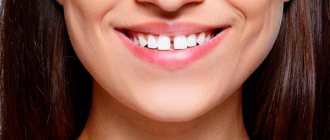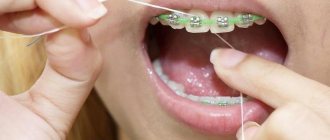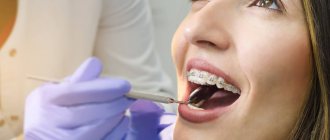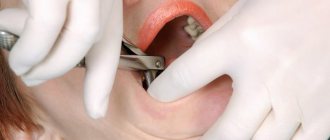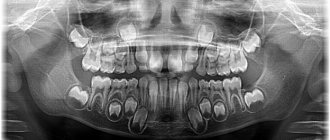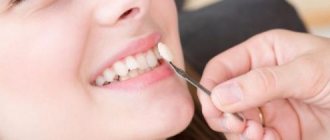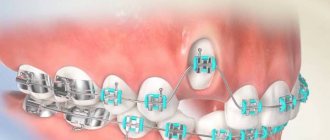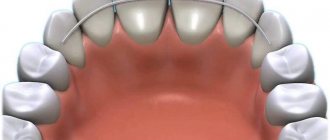Uneven teeth or malocclusion have long ceased to be a problem for modern people. All this can be completely solved with the help of braces. But many do not know that before the procedure there is a process of careful preparation. This includes: professional cleaning, sanitation and other operations.
The presence of any structures on the teeth does not make a person an outcast of society, as it was several decades ago. Now, on the contrary, it is an indicator of caring for one’s own health, regardless of age. After all, straight and beautiful teeth are the pride of their owner.
What are braces?
A special orthodontic device aimed at leveling malocclusion, eliminating spaces and gaps between teeth, as well as correcting the direction of their growth, is actually called braces.
The bracket system consists of the following elements:
- bracket - its material can be different;
- metal arc;
- fastening (ligature) - this part is not always present in the design.
Each brace looks like a small plate that is firmly attached to the tooth enamel and connected to the arch. The degree of arc tension is adjusted manually. By continuously applying pressure to the tooth, it moves into the desired position. The thicker the arch, the more pressure the structure exerts on the dentition.
In addition to orthodontic treatment of the dental system, modern youth perceives braces as a manifestation of individuality and self-expression.
Since wearing braces takes quite a long period, many patients strive to get a model that will be almost invisible or look like a decoration.
You can choose the bracket plate based on your own preferences or financial capabilities. The following options are available to choose from:
- plastic;
- metal;
- ceramic;
- sapphire;
- combined.
The latter is a combination of metal and ceramics in one row, or the installation of ceramic braces on the upper jaw, and metal ones on the lower jaw.
In terms of pricing policy, you should know that the most inexpensive material for these products is metal, and the most expensive are ceramics and sapphire. They can be given an individual design or made to order. The appearance of children's braces is slightly different from models for adults.
It is worth familiarizing yourself with the possibility of installing a lingual correction system . Its difference is that it is attached to the inside of the teeth and remains invisible to others. The time required to install this type of braces on the upper jaw is calculated by the doctor in order to minimize the patient’s discomfort.
From an aesthetic point of view, the lingual brace system has a number of advantages, but, on the other hand, the adaptation period takes longer, and the pain is more pronounced.
Another type of braces that you need to know about before starting teeth correction is non-ligature models .
These are fairly new, modern products. Their main difference from ligature installations is the absence of fasteners on the plate. Thanks to this, the structure on the teeth looks much smaller. This detail allows you to carry out daily hygiene procedures faster and more comfortably.
Where do the best orthodontists in Krasnoyarsk work?
How to find your doctor and find out where the best orthodontists in Krasnoyarsk work? Most patients are introduced to different specialists and then choose from them. To solve the problem of bite, it is worth consulting with several orthodontists. And then choose the one who seems more competent, caring and attentive to you. It also matters what kind of braces and aligners the clinic works with. For example, in Mira dentistry, patients are offered a large selection of designs with different parameters: material, cost, treatment period, size.
Take your time when choosing a specialist who treats orthodontic diseases. Once you find the perfect doctor for you, your years in braces will fly by!
Who should have braces on their teeth?
When the dentition is deformed, it is visually difficult to determine whether it is necessary to install braces or whether you can do without them. In any case, consultation with an orthodontist cannot be avoided.
Only diagnostic studies can be an indicator for decision making.
If the doctor sees that the jaw is in the stage of intensive growth, and the curvatures are insignificant, then it is possible to do without installing a brace system. Or, as an option, postpone the procedure for some period, continuing to monitor the formation of the dentition.
Orthodontic structures are installed according to medical indicators:
- with the wrong direction of growth of permanent teeth;
- the need for bite correction;
- to eliminate the negative consequences of injuries or congenital pathologies.
In particularly difficult cases, when the roots of the teeth are intertwined, surgical intervention is necessary, followed by fixation with braces. This treatment option can be quite lengthy but is quite effective.
At what age are braces installed?
Braces are usually placed on teenagers aged 12-14 years. During this period, active formation of the bite and replacement of teeth occurs, which makes the treatment effective. The correction period takes 1-2 years, and the result lasts for life.
In rare cases, the time frame is shifted. Braces are placed on children:
- 8-11 years old – use a simplified system to correct the growth of the front teeth;
- 15-16 years old - according to indications and with the consent of the teenage patient.
Soldatenkova Alina
Orthodontic treatment with braces is popular today among adults. But this is not a reason to delay the correction. We explain to patients: if the period of wearing braces in adolescents is one or two years, then in adults this period increases significantly.
Contraindications
Unfortunately, not all patients can correct defects in the dental system with braces. There are a number of contraindications for wearing them. If any are present, they will definitely be identified during diagnosis.
To eliminate some negatively influencing factors, it is enough to carry out procedures or a course of treatment before the upcoming installation of braces.
The influencing factors that can be eliminated include the following diseases:
- early stage periodontitis;
- non-advanced periodontal disease;
- caries or its consequences.
A temporary allergic reaction to some materials included in the structure may also occur. This happens with individual intolerance to any substances. The problem is eliminated by replacing the irritant with another, hypoallergenic component.
However, there are diseases in which the installation of braces is strictly prohibited. Among them:
- oncological diseases;
- tuberculosis;
- HIV or AIDS;
- osteoporosis or other bone tissue pathologies;
- disorders of the cardiovascular, endocrine or circulatory system;
- severe forms of periodontal disease and periodontitis;
- mental disorders.
If the patient’s medical history contains an absolute contraindication for the installation of braces, but the dentition or bite requires immediate treatment, a solution can be found. At “People's Dentistry”, the orthodontist considers all possible options and selects the optimal method of correction.
When should you see a doctor?
Let's consider the cases in which you need to see an orthodontist:
- If there are defects that spoil the aesthetic condition of the smile, the patient can voluntarily consult a doctor.
- In case of disorders of the dentofacial apparatus (for example, complications after prosthetics or tissue damage), a visit to the orthodontist is simply necessary.
- Formation of a deep bite.
- The lower jaw is positioned incorrectly.
- The presence of negative habits (speech deviations, the patient often sucks his finger, etc.).
- Curled teeth.
- Secondary malocclusion.
The services of an orthodontist can eliminate problems that interfere with prosthetics, or make it possible to avoid them.
An orthodontist also treats caries, periodontitis, periodontal disease and gingivitis.
Where to go?
Usually, parents notice a crooked dentition in their child when baby teeth are replaced by permanent teeth. If such a problem exists, there is a direct path to the orthodontist. It is this specialist who determines whether braces are needed on the teeth. In addition, any imperfections can be corrected not only in adolescence. Narodnaya dental specialists have experience in successfully correcting the dental system of patients of various age categories.
If the decision to install the structure is positive, the orthodontist plans the procedure in detail and calculates the result of the treatment. An initial visit to the clinic involves the following studies:
- examination of the oral cavity to identify teeth requiring sanitation;
- current level of hygiene;
- condition of wisdom teeth
- familiarization with the types of bracket systems;
- referral for diagnostics.
Features of treatment for adults and children
Many parents make mistakes when they do not promptly treat malocclusion in children. Doctors say the earlier the correction begins, the more effective the result will be.
It is considered ideal to see an orthodontist for children as young as 2 years old. In this case, he will be able to identify possible congenital malocclusions already at the stage of growth of baby teeth (it is by this age that most of the dentition appears in children). At this age, correction is not done with braces, but with special aligners or mouth guards. Timely implementation of such a procedure helps to avoid many problems in the future.
For adult patients, doctors most often install permanent types of braces, mostly made of metal. They are considered the most durable and effective. When installing such structures, the patient often feels discomfort, so if necessary, the doctor can use anesthesia.
Carrying out diagnostics
Before installing braces, the following diagnostic studies are required:
- orthopantomogram - a panoramic image of the jaw bones, allowing you to see the location of all teeth, their rudiments and roots;
- teleroentgenogram – lateral projection of the skull bones. With its help, the direction of tooth growth is determined for the correct calculation of correction angles;
- photographic recording of teeth and face from different angles;
- casts of the jaws - models are made from them, on the basis of which the design of braces is individually developed;
- articulatory studies.
The “People's Dentistry” clinic is one of the best in St. Petersburg, as it is equipped with the latest equipment for diagnosing and treating dental problems of any complexity. This facilitates the implementation of all diagnostic measures in the shortest possible time.
Description of structures that can correct the bite
Aligners or mouthguards are structures made of heavy-duty materials.
Advantages of aligners:
- Possibility to remove the structure;
- Made from discreet transparent material;
- Minimal discomfort when wearing;
- There is no need for special care (except for normal hygiene and rinsing with water).
Trainers are structures that are worn for several hours a day, depending on doctor’s orders. They are produced in series, which makes them affordable. Designed to correct minor changes in bite. With their help, it is good to align teeth that are located separately from each other.
Braces are small brackets connected by a power arc. Such designs are capable of correcting a large number of different deviations.
Note: They are worn depending on the initial curvature of the teeth and the body’s adaptation to changes, from two months to five years.
Planning the result
At this stage, the orthodontist realistically evaluates all the diagnostic results obtained and calculates the order of the upcoming installation of braces. A decision is made about whether teeth need to be installed before braces. All stages and the order of their implementation are discussed with the patient.
The time of wearing the corrective structure depends, first of all, on the complexity of the deformation of the dentition.
This process is always purely individual. The average duration of treatment is from 12 to 24 months.
If necessary, the patient receives a referral to other specialized specialists for complete comprehensive sanitation of the oral cavity. At Narodnaya Dentistry, all specialists work harmoniously and purposefully. Having our own modern equipment allows us to make a diagnosis in the shortest possible time and begin treatment immediately.
Stages of treatment by an orthodontist
At the beginning of treatment, the specialist conducts a diagnosis, which largely determines the final result.
The patient goes through the following stages:
- Visual inspection. The doctor studies the symmetry of the face, shape, profile and features of the oral cavity. An assessment is made of the general appearance of the teeth and jaws. The movement of the jaw and the closure of teeth are studied. The examination helps to identify how severely the bite is deformed and determine how difficult and long the treatment will be.
- An oral x-ray gives a general picture of the condition of the jaws and teeth. The image shows features that may not be noticed during normal examination.
- Making plaster models based on dental impressions taken. The model shows the location of the teeth, all the cusps and pits of the jaw. The specialist measures the necessary parameters and determines possible deviations. All features of the planned design must be taken into account at this stage.
Having determined the diagnosis, the specialist decides on a method to correct the problem:
- myotherapy - used only for small patients who are not allowed to have braces. Gymnastics of the jaws is carried out, during which children are given a correct bite that has not had time to form. The method cannot guarantee a 100% result. Gymnastics can also be used for adult patients when there are features that resist the use of other methods;
- hardware - used for patients of any age. For adults, the adjustment will take one to two years longer than for children. The procedure itself takes about an hour. The doctor installs braces, plates or aligners;
- surgical - used when there is no room in the mouth for teeth to grow or they are severely twisted.
Tooth extraction
You need to be prepared for the fact that before installing braces you will have to have your wisdom teeth removed. As practice shows, in approximately 90% of cases these teeth have to be removed. For some reason, they are in an incorrect position and, when they erupt, cause pain and discomfort, and also deform nearby teeth.
However, it is possible that it may be necessary to remove more than just wisdom teeth. When premolars grow on top of each other, correcting them with braces may be impossible. The only way to obtain an even dentition is to remove interfering specimens before installing the structure.
Advantages of bite correction without braces at the Federal Scientific and Clinical Center FMBA
Orthodontics, as one of the most important branches of dentistry, is becoming increasingly important. At the Federal Scientific and Clinical Center FMBA, teeth straightening is ensured using modern methods of orthodontic treatment and the clinic’s advanced material and technical base.
The main advantages of our center:
- high qualifications, experience, artistic skill of doctors;
- use of high-quality materials with the best characteristics;
- equipping the center with modern computer technologies that make it possible to accurately simulate the treatment process;
- interaction with trusted manufacturers;
- wide scientific and clinical base, participation in specialized seminars and conferences;
- possibility of treatment in different ways;
- a large number of positive reviews from satisfied patients.
Preparing to install braces
Before the procedure, professional cleaning of the oral cavity is required. The hygienist performs the following manipulations:
- removes soft and hard plaque;
- cleans teeth from stones;
- seals chewing teeth with a fluoride-containing substance;
- determines the condition of the enamel; if necessary, a remineralization course can be prescribed.
If signs of caries are detected, you will have to be treated by a dentist. And if a preliminary examination shows that plastic surgery of the lingual frenulum is necessary, the patient will be referred to a dental surgeon.
In “People's Dentistry”, all specialists of a narrow focus cooperate harmoniously to achieve the fastest positive result.
Advantages of aligners over braces
The two main advantages - aesthetics and wearing comfort - are due to the design of this product. This allows you not to experience embarrassment during treatment, as happens when wearing braces, when a person is embarrassed to smile and talk, experiencing stress and becoming withdrawn, refusing to communicate. Aligners eliminate such problems - they make you look the same as usual, and in extreme cases they can be removed altogether.
Aligners are more effective than braces in another respect: there are almost no restrictions on food intake. Even solid foods can be eaten if they are removed before meals. It is impossible to remove the braces for a while, so you will have to eat in them, which means you will have to give up solid food, which can break the structure, and after eating, rinse your mouth thoroughly and brush your teeth using special brushes and toothpicks, since food gets stuck between them much more strongly. teeth.
Well, difficulties in oral hygiene will result in the development of caries if the patient allows himself to relax and not be too diligent in caring for the oral cavity. When using aligners, such problems do not arise, you can eat and brush your teeth as usual.
Finally, what makes you choose aligners instead of braces is their purely medical effectiveness - treatment with aligners is faster, and you can change the aligners yourself if necessary. Aligners cover the teeth more tightly and transfer the load to them more evenly, allowing them to be moved in several axes at once, which speeds up treatment and at the same time makes it safer and more comfortable.
How to install braces
In our clinic, the orthodontist uses the method of indirect fixation of braces, which significantly reduces the installation time of the brace system; instead of an hour and a half, you can fix the brace system on one jaw in just 20-30 minutes. Braces are located in a mouthguard, which is fixed to all teeth. First, the teeth are processed, glue is applied, then a mouthguard is installed, illuminated with a special lamp and removed. Braces remain on the teeth.
First, the device is fixed on the upper jaw. The addiction process takes from 7 to 21 days. After about a month, you can install braces on the lower jaw.
All stages of installation and adjustment of the braces design are carried out exclusively by an orthodontist and only within the clinic.
How to find a good doctor
Choosing a good orthodontist is not always easy. The effectiveness of treatment is influenced by many different factors - the quality of braces, the skill of the doctor, and the individual characteristics of the patient.
The Shifa Clinic is a modern medical center offering patients the highest quality orthodontic care. Our doctors use modern techniques and braces, the effectiveness of which has been confirmed by a number of clinical studies.
Despite extensive experience working with braces, our center’s specialists constantly attend specialized trainings and seminars to improve their own professionalism. This allows us not to stop there and provide patients with only the highest quality services.
Orthodontists at the Shifa clinic work to ensure that people’s smiles are always healthy and beautiful. Contact dentists at convenient hours without queuing!
